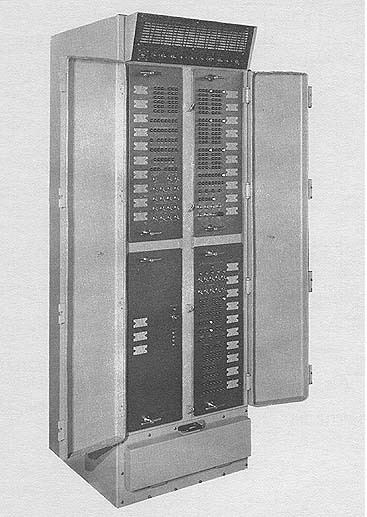 | ||
The UNIVAC 418 was a transistorized, 18-bit word core memory machine made by Sperry Univac. The name came from its 4-microsecond memory cycle time and 18-bit word. The assembly language for this class of computers was TRIM III and ART418.
Contents
Over the three different models, more than 392 systems were manufactured. It evolved from the Control Unit Tester (CUT), a device used in the factory to test peripherals for larger systems.
Architecture
The instruction word had three formats:
Format I - common Load, Store, and Arithmetic operationsNumbers were represented in ones' complement, single and double precision. The TRIM assembly source code used octal numbers as opposed to more common hexadecimal because the 18-bit words are evenly divisible by 3, but not by 4.
The machine had the following addressable registers:
All register values were displayed in real time on the front panel of the computer in binary, with the ability of the user to enter new values via push button (a function that was safe to perform only when the computer was not in run mode).
UNIVAC 418-I
The first UNIVAC 418-I was delivered in June 1963. It was available with 4,096 to 16,384 words of memory.
UNIVAC 1218 Military Computer
The 418-I was also available in a militarized version as the UNIVAC 1218. It was almost 6 feet tall and weighed 775 lb. It required both 115VAC, 1-phase, 60 Hz and 115VAC, 3-phase, 400 Hz power.
UNIVAC 418-II
The first UNIVAC 418-II was delivered in November 1964. It was available with 4,096 to 65,536 (18-bit) words of memory. Memory cycle time was reduced to 2 microseconds. The militarized version was called the UNIVAC 1219 (known as the "Mk 152 Fire Control Computer.") It was part of the Navy's Mk 76 missile fire control system, used to control the AN/SPG-55 radar system.
UNIVAC 418-III
The first UNIVAC 418-III was delivered in 1969. It was available with 32,768 to 131,072 words of memory. Memory cycle time was reduced to 750 nanoseconds. New instructions were added for floating-point arithmetic, binary-to-decimal and decimal-to-binary conversions, and block transfers up to 64 words. The SR register was expanded to 6 bits. The 418-III had two unique hardware features which enabled it to handle continuously high speed serial character streams. One was called the buffer overflow interrupt and the other hardware buffer chaining. By the 1990s, all the 418 hardware was gone, but the California Department of Water Resources was still running 418 emulation on a UNIVAC 1100/60.
